The Meaning And Power Of Smell - IELTS Reading Answers
10 min read
Updated On
-
Copy link
Get set to begin your exam preparations and score a band 9 with this “The Meaning And Power Of Smell - IELTS Reading” topic and check our expert explanations to them as well!
Table of Contents

Limited-Time Offer : Access a FREE 10-Day IELTS Study Plan!
The IELTS Reading test consists of different question types and are to be answered in one hour. The Reading Passage, “The Meaning And Power Of Smell,” is a passage that appeared previously in the IELTS Reading Exam.
You are not completely prepared for a Reading test until you have practiced passages such as ‘The Meaning And Power Of Smell.’ So get set to find the answers to get an idea of the difficulty level of the real reading passages.
Reading Passage - The Meaning And Power Of Smell
The sense of smell, or olfaction, is powerful. Odours affect us on a physical, psychological and social level. For the most part, however, we breathe in the aromas which surround us without being consciously aware of their importance to us. It is only when the faculty of smell is impaired for some reason that we begin to realise the essential role the sense of smell plays in our sense of well-being
A. A survey conducted by Anthony Synott at Montreal’s Concordia University asked participants to comment on how important smell was to them in their lives. It became apparent that smell can evoke strong emotional responses. A scent associated with a good experience can bring a rush of joy, while a foul odour or one associated with a bad memory may make us grimace with disgust. Respondents to the survey noted that many of their olfactory likes and dislikes were based on emotional associations. Such associations can be powerful enough so that odours that we would generally label unpleasant become agreeable, and those that we would generally consider fragrant become disagreeable for particular individuals. The perception of smell, therefore, consists not only of the sensation of the odours themselves, but of the experiences and emotions associated with them.
B. Odours are also essential cues in social bonding. One respondent to the survey believed that there is no true emotional bonding without touching and smelling a loved one. In fact, infants recognise the odours of their mothers soon after birth and adults can often identify their children or spouses by scent. In one well-known test, women and men were able to distinguish by smell alone clothing worn by their marriage partners from similar clothing worn by other people. Most of the subjects would probably never have given much thought to odour as a cue for identifying family members before being involved in the test, but as the experiment revealed, even when not consciously considered, smells register.
C. In spite of its importance to our emotional and sensory lives, smell is probably the most undervalued sense in many cultures. The reason often given for the low regard in which smell is held is that, in comparison with its importance among animals, the human sense of smell is feeble and undeveloped. While it is true that the olfactory powers of humans are nothing like as fine as those possessed by certain animals, they are still remarkably acute. Our noses are able to recognise thousands of smells, and to perceive odours which are present only in extremely small quantities.
D. Smell, however, is a highly elusive phenomenon. Odours, unlike colours, for instance, cannot be named in many languages because the specific vocabulary simply doesn’t exist. ‘It smells like . . . ,’ we have to say when describing an odour, struggling to express our olfactory experience. Nor can odours be recorded: there is no effective way to either capture or store them over time. In the realm of olfaction, we must make do with descriptions and recollections. This has implications for olfactory research.
E. Most of the research on smell undertaken to date has been of a physical scientific nature. Significant advances have been made in the understanding of the biological and chemical nature of olfaction, but many fundamental questions have yet to be answered. Researchers have still to decide whether smell is one sense or two - one responding to odours proper and the other registering odourless chemicals in the air. Other unanswered questions are whether the nose is the only part of the body affected by odours, and how smells can be measured objectively given the nonphysical components. Questions like these mean that interest in the psychology of smell is inevitably set to play an increasingly important role for researchers.
F. However, smell is not simply a biological and psychological phenomenon. Smell is cultural, hence it is a social and historical phenomenon. Odours are invested with cultural values: smells that are considered to be offensive in some cultures may be perfectly acceptable in others. Therefore, our sense of smell is a means of, and model for, interacting with the world. Different smells can provide us with intimate and emotionally charged experiences and the value that we attach to these experiences is interiorised by the members of society in a deeply personal way. Importantly, our commonly held feelings about smells can help distinguish us from other cultures. The study of the cultural history of smell is, therefore, in a very real sense, an investigation into the essence of human culture.
Questions
1-6
Reading Passage 3 has six paragraphs, A-F.
Choose the correct heading for each paragraph from the list of headings below.
Write the correct number, i-viii, in boxes 1-6 on your answer sheet.
List of Headings
i The difficulties of talking about smells
ii The role of smell in personal relationships
iii Future studies into smell
iv The relationship between the brain and the nose
v The interpretation of smells as a factor in defining groups
vi Why our sense of smell is not appreciated
vii Smell is our superior sense
viii The relationship between smell and feelings
1 Paragraph A
2 Paragraph B
3 Paragraph C
4 Paragraph D
5 Paragraph E
6 Paragraph F
Questions 7-10
Choose the correct letter, A, B, C or D.
Write the correct letter in boxes 7-10 on your answer sheet.
7 According to the introduction, we become aware of the importance of smell when
A. we discover a new smell.
B. we experience a powerful smell.
C. our ability to smell is damaged.
D. we are surrounded by odours.
8 The experiment described in paragraph B
A. shows how we make use of smell without realising it.
B. demonstrates that family members have a similar smell.
C. proves that a sense of smell is learnt.
D. compares the sense of smell in males and females.
9 What is the writer doing in paragraph C?
A. supporting other research
B. making a proposal
C. rejecting a common belief
D. describing limitations
10 What does the writer suggest about the study of smell in the atmosphere in paragraph E?
A. The measurement of smell is becoming more accurate.
B. Researchers believe smell is a purely physical reaction.
C. Most smells are inoffensive.
D. Smell is yet to be defined.
Questions 11-14
Complete the sentences below.
Choose ONE WORD ONLY from the passage for each answer.
Write your answers in boxes 11-14 on your answer sheet.
11 Tests have shown that odours can help people recognise the ____________ belonging to their husbands and wives.
12 Certain linguistic groups may have difficulty describing smell because they lack the appropriate ___________
13 The sense of smell may involve response to _____________ which do not smell, in addition to obvious odours.
14 Odours regarded as unpleasant in certain _____________ are not regarded as unpleasant in others.
Answers to IELTS Reading - The Meaning And Power Of Smell
Unlock Answers
| Question number | Answer | Explanation |
|---|---|---|
| 1 | viii | Paragraph A brings out the fact that with the help of a survey conducted by Anthony Synott at Montreal’s Concordia University, it became apparent that ‘smell can evoke’ ‘strong emotional responses’ (feelings). For example, a scent associated with a good experience can bring a rush of joy, while a foul odour or one associated with a bad memory may make us grimace with disgust. Hence, the answer is viii (The relationship between smell and feelings). |
| 2 | ii | Paragraph B states that odours (smells) are also essential cues in social bonding (personal relationships). In fact, infants recognise the odours of their mothers soon after birth and adults can often identify their children or spouses by scent. Hence, the answer is ii (The role of smell in personal relationships). |
| 3 | vi | Paragraph C explains why smell is probably the most undervalued sense in many cultures. The reason for the low regard in which smell is held is that the human sense of smell is feeble and undeveloped. Our noses are able to recognise thousands of smells, and to perceive odours which are present only in extremely small quantities. Hence, the answer is vi (Why our sense of smell is not appreciated). |
| 4 | i | Paragraph D mentions that smell is a highly elusive phenomenon as they cannot be named in many languages because the specific vocabulary simply doesn’t exist. Moreover, odours cannot be recorded: there is no effective way to either capture or store them over time. Hence, the answer is i (The difficulties of talking about smells). |
| 5 | iii | Paragraph E points out that researchers have still to decide whether smell is one sense or two – one responding to odours properly and the other registering odourless chemicals in the air. Questions like whether the nose is the only part of the body affected by odours, and how smells can be measured objectively given the nonphysical components mean that interest in the psychology of smell is inevitably set to play an increasingly important role for researchers. These queries will motivate researchers to study the sense in future. Hence, the answer is iii (Future studies into smell). |
| 6 | v | Paragraph F communicates that our commonly held feelings about smells can help distinguish us from other cultures. This means that varying notions about smell differentiate each culture or community from each other and thus separate them from each other. Hence, the answer is v (The interpretation of smells as a factor in defining groups). |
| 7 | C | According to the introduction, it is only when the faculty of smell is impaired, that is, the sense/ability of smell is damaged for some reason, that we begin to realise the essential role the sense of smell (become aware of the importance of smell) plays in our sense of well-being. Hence, the answer is C (our ability to smell is damaged). |
| 8 | A | Paragraph B indicates that in one well-known test, most of the subjects probably never have given much thought (without realising it) to odour as a cue for identifying family members (make use of smell) before being involved in the test, but as the experiment revealed, even when not consciously considered, smells register. Hence, the answer is A (shows how we make use of smell without realising it). |
| 9 | C | Paragraph C informs that in spite of its importance to our emotional and sensory lives, smell is probably the most undervalued sense in many cultures. While it is true (as commonly believed by everyone) that the olfactory powers of humans are nothing like as fine as those possessed by certain animals, they are still remarkably acute (sense of smell is essential for our well being). So, the author points out that though we may accept that smell is unimportant, it is not true, thereby rejecting widely accepted belief. Hence, the answer is C (rejecting a common belief). |
| 10 | D | Paragraph E lets out the fact that significant advances have been made in the understanding of the biological and chemical nature of olfaction, but many fundamental questions have yet to be answered. Researchers have still to decide whether smell is one sense or two – one responding to odours properly and the other registering odourless chemicals in the air. From this, we can derive that many questions about smell are yet to be unanswered and its properties have to be defined. Hence, the answer is D (Smell is yet to be defined). |
| 11 | clothing | Paragraph B considers the fact that in one well-known test, women and men were able to distinguish by smell (odours can help people recognise) clothing worn by their marriage partners (belonging to their husbands and wives) from similar clothing worn by other people. Hence, the answer is ‘clothing’. |
| 12 | vocabulary | Paragraph D suggests that odours, unlike colours, for instance, cannot be named ( difficulty describing smell) in many languages(certain linguistic groups) because the specific vocabulary simply doesn’t exist (lack the appropriate vocabulary). Hence, the answer is ‘vocabulary’. |
| 13 | chemicals | Paragraph E intimates that researchers have still to decide whether smell is one sense or two – one responding to odours proper (obvious odours) and the other registering odourless chemicals (chemicals that do not smell) in the air. Hence, the answer is ‘chemicals’. |
| 14 | cultures | Paragraph F declares that odours are invested with cultural values: smells that are considered to be offensive (odours regarded as unpleasant) in some cultures may be perfectly acceptable (not regarded as unpleasant) in others. Hence, the answer is ‘cultures’. |
Check More IELTS Reading Answers
| Volcanoes Earth Shattering News Answers | Land Of The Rising Sun Answers |
| The Motor Car Answers | The Truth About The Environment Answers |
| Moles Happy As Homes Go Underground Answers | Robots Reading Answers |
Also check:
Practice IELTS Reading based on question types

Start Preparing for IELTS: Get Your 10-Day Study Plan Today!
Recent Articles

Nehasri Ravishenbagam

Haniya Yashfeen

Haniya Yashfeen

Haniya Yashfeen




Post your Comments